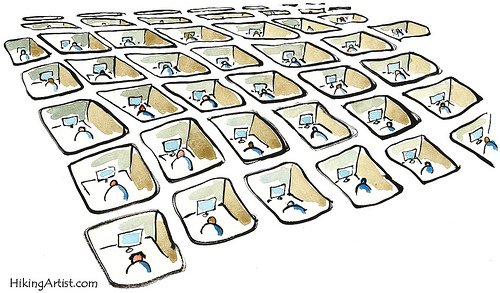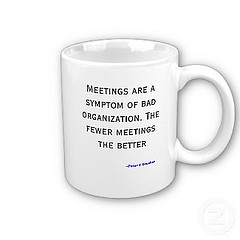 It’s May Day and it was actually sunny all day long. This is a big deal here in the great Pacific Northwest, where we are having our second cool, rainy, late spring. I spent the day in my yard, moving a few plants, but mostly pulling weeds. It was great. Dan McCarthy spent a few hours of his day putting together this month’s Leadership Carnival. Guess who had more fun?
It’s May Day and it was actually sunny all day long. This is a big deal here in the great Pacific Northwest, where we are having our second cool, rainy, late spring. I spent the day in my yard, moving a few plants, but mostly pulling weeds. It was great. Dan McCarthy spent a few hours of his day putting together this month’s Leadership Carnival. Guess who had more fun?
So without more ado, here is The May 1st Leadership Development Carnival; Thanks, Dan!
We’ll start off with a post from Jennifer Miller, called “8 Ways for CEOs to Tap Thier Insiders“, posted at The People Equation, saying “Management by walking around gets a fresh look with this research that touts productivity gains for CEOs who build relationships with company insiders”.
Next up is Wally Bock, with “You don’t “build” people, dammit!”, hosted at his Three Star Leadership blog, saying “People are living things. You don’t build living things, they grow.”
Steve Roesler presents Real Change: Add Behavior to Your Vision posted at All Things Workplace, saying, “Leading Change means getting beyond the vision and impacting behavior.”
Mary Jo Asmus presents Reflecting On Your 360 Degree Feedback posted at Mary Jo Asmus.
Art Petty presents Trying Not to Fail Is Not the Same As Striving for Success posted at Management Excellence.
Sharlyn Lauby presents If You’re Not With Us posted at hr bartender, saying, “Part of management is being able to help employees manage their workload.”
Mark Stelzner presents Will I Fit In? posted at Inflexion Point.
David Burkus presents The Designful Leader posted at LeaderLab.
Anne Pershel gives us Power: How to Build it over Time & Lose it Overnight, posted at Germane Insights, saying “I learned the hard way to respect the dynamics of power in organizational life. In this post you will read the story and lessons learned.”
Eric Pennington presents The Giving Up Thing posted at Epic Living – Leadership Development , saying, “In this post I address the crossroads of “giving up.” The reasons we’re tempted to give up and the key reasons to keep going are addressed in this timely piece.”
William Matthies presents A Macro Business Plan? posted at Business Wisdom: Words to Manage By, saying, “Life guidance will hopefully be grounded in positive ethics.”
Bret L. Simmons presents Employee Empowerment: Why It Matters And How To Get It posted at Bret L. Simmons.
Mike Henry Sr. presents a post from Deb Costello called “Inspiration vs. Perspiration” posted at Lead Change Group Blog, saying, “You are a leader in your work whether you have that title or not. People see you do your job. Do you do it joyfully or are you working for the weekend?”
Miki Saxon presents Ducks In A Row: Are You Well-Put-Together? posted at MAPping Company Success, saying, “Based on today’s definition, well-put-together is the last thing you want to be.”
Erik Samdahl presents Dance With the One What Brung Ya posted at Productivity Blog, saying, “Howard Schultz’s focus since returning to the helm of Starbucks has been to remind the company of what made it great from its beginnings and, in effect, re-teaching all levels of the company how to execute against its original brand promise.”
Jon Ingham presents John Lewis’ Co-Ownership Model and The Royal Wedding posted at Management 2.0 developing social capital.
Anna Farmery presents Connecting Bill Clinton, music, Elvis and business! posted at The Engaging Brand.
Utpal Vaishnav presents Entrepreneurship 30 posted at Utpal Vaishnav, saying, “30 thoughts to know whether Entrepreneurship is for you or not.”
Adi Gaskell presents Do entrepreneurs think differently? | Chartered Management Institute posted at Do entrepreneurs think differently?, saying, “New research into the type of behaviour differences between entrepreneurs and managers.”
Michael Cardus presents 2 Kinds of Workplaces. 1 of Paranoia 1 of Trust posted at Create-Learning Team Building & Leadership Blog, saying, “The workplace has the capacity to develop paranoia and/or trust. Psychologically when aroused either mechanism in people readily takes over. They magnify and distort the reality that is separate from our perception and experience.”
Meg Bear presents Bring your whole self to work posted at TalentedApps, saying, “Encouraging employees to be full and complete people — with a wealth of experiences, ideas, commitments, values and thoughts to offer your company, is a linchpin for most engagement strategies.”
Laura Schroeder presents Top Ten Tips for Managers posted at Working Girl.
These posts were all submitted by Becky Robinson:
From Guy Harris, “Three Clues You Can Use to Find Out What Motivates Another Person.” The key to motivating others is understanding what they view as rewards.
From Becky’s own blog, “Share What You Know.” Leaders can make a difference by freely sharing their ideas, wisdom, and insights with others.
Finally, from the Bud to Boss Community blog, this post from featured blogger
Phil Gerbyshak:
“Communication: Giving Better Directions.” In this post, Phil shares some great tips leaders can use to communicate more effectively.
Debbie Owen presents How to Bring About Sustainable Change posted at Online Doctorate Degree.
Chris Edmonds presents The Leader’s Primary Contribution: Discretionary Energy posted at Driving Results Through Culture.
Jason Price presents The Biggest Lie of Leadership posted at One Money Design, saying, “This post shares an important ingredient of good leadership which is most often not what people see when thinking of leaders.”
Joe Tichio presents Inspirational Leadership Quotes posted at Inspirational Quotes Blog, saying, “A collection of inspiring quotes on leadership and being a leader.”
Robert Tanner presents Leading Change (Step 5): Empower Broad Based Action | Management is a Journey Blog posted at Management is a Journey Blog, saying, “This article provides strategies on implementing Step 5 of John Kotter’s Leading Change Model–empower broad based action.”
Andy Klein presents A leader’s dilemma: What’s the best way to influence action? posted at Fortune Group Blog, saying, “Leaders are confronted with two options when trying to influence people to act. To us, picking between the two is an easy choice.”
Bob Lieberman presents Nobody Wants To Know Me Anymore posted at Cultivating Creativity – Developing Leaders for the Creative Economy.
Alicia Arnold presents 5 Ways to Get Out of a Creative Slump posted at Daily Creativity, saying, “Around the globe, innovation is cited as one of the top three leadership skills for the future. This article provides easy to implement tips for increasing personal creativity as a building block for harnessing creativity and innovation with the workplace.”
Image credit: Great Leadership
 A few weeks ago I was talking to “Carl,” an entrepreneur, about the problems he was having launching his product.
A few weeks ago I was talking to “Carl,” an entrepreneur, about the problems he was having launching his product.



 Image credit:
Image credit:  John Greathouse is a VC at Rincon Venture Partners and he offers up some great advice about
John Greathouse is a VC at Rincon Venture Partners and he offers up some great advice about  It’s May Day and it was actually sunny all day long. This is a big deal here in the great Pacific Northwest, where we are having our second cool, rainy, late spring. I spent the day in my yard, moving a few plants, but mostly pulling weeds. It was great. Dan McCarthy spent a few hours of his day putting together this month’s Leadership Carnival. Guess who had more fun?
It’s May Day and it was actually sunny all day long. This is a big deal here in the great Pacific Northwest, where we are having our second cool, rainy, late spring. I spent the day in my yard, moving a few plants, but mostly pulling weeds. It was great. Dan McCarthy spent a few hours of his day putting together this month’s Leadership Carnival. Guess who had more fun?
 When most people think about
When most people think about 
